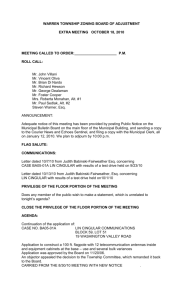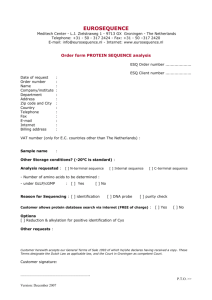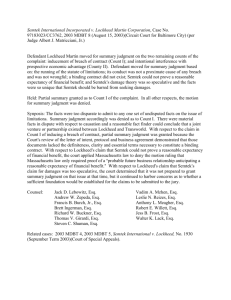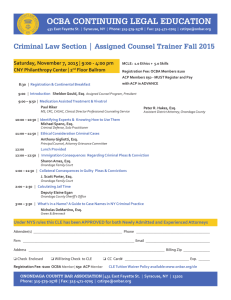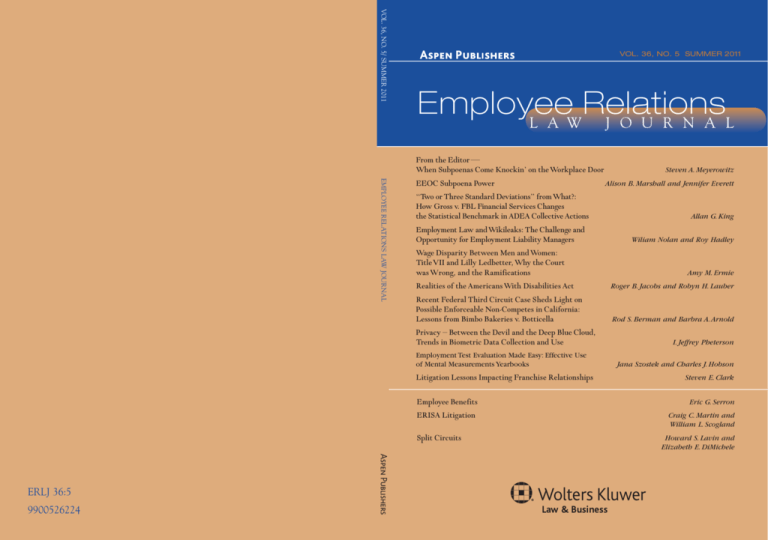
VOL. 36, NO. 5/ SUMMER 2011
VOL. 36, NO. 5 SUMMER 2011
Employee
Relations
L A W
J O U R N A L
From the Editor —
When Subpoenas Come Knockin’ on the Workplace Door
EMPLOYEE RELATIONS LAW JOURNAL
EEOC Subpoena Power
“Two or Three Standard Deviations” from What?:
How Gross v. FBL Financial Services Changes
the Statistical Benchmark in ADEA Collective Actions
Employment Law and Wikileaks: The Challenge and
Opportunity for Employment Liability Managers
Wage Disparity Between Men and Women:
Title VII and Lilly Ledbetter, Why the Court
was Wrong, and the Ramifications
Realities of the Americans With Disabilities Act
Recent Federal Third Circuit Case Sheds Light on
Possible Enforceable Non-Competes in California:
Lessons from Bimbo Bakeries v. Botticella
Privacy – Between the Devil and the Deep Blue Cloud,
Trends in Biometric Data Collection and Use
Employment Test Evaluation Made Easy: Effective Use
of Mental Measurements Yearbooks
Litigation Lessons Impacting Franchise Relationships
Employee Benefits
ERISA Litigation
Split Circuits
ERLJ 36:5
9900526224
Steven A. Meyerowitz
Alison B. Marshall and Jennifer Everett
Allan G. King
Wiliam Nolan and Roy Hadley
Amy M. Ermie
Roger B. Jacobs and Robyn H. Lauber
Rod S. Berman and Barbra A. Arnold
I. Jeffrey Pheterson
Jana Szostek and Charles J. Hobson
Steven E. Clark
Eric G. Serron
Craig C. Martin and
William L. Scogland
Howard S. Lavin and
Elizabeth E. DiMichele
Employee Relations
Law Journal
EDITOR-IN-CHIEF
Steven A. Meyerowitz
EDITOR
Elizabeth Venturo
SENIOR MANAGING EDITOR
Joanne Mitchell-George
PUBLISHER
Paul Gibson
This publication is designed to provide accurate and authoritative information in regard to the subject matter covered. It is sold with the understanding that the publisher is not engaged in rendering legal, accounting, or other
professional service. If legal advice or other expert assistance is required,
the services of a competent professional person should be sought—From a
Declaration of Principles jointly adopted by a Committee of the American
Bar Association and a Committee of Publishers.
Copyright © 2011 CCH Incorporated.
All Rights Reserved.
EMPLOYEE RELATIONS LAW JOURNAL (ISSN 0098-8898)
(USPS 407-630) is published quarterly by Aspen Publishers, 76 Ninth
Avenue, Seventh Floor, New York, NY 10011. One year subscription
rate: $469; two year: $797; three year: $1,126; single issue: $141. To
subscribe, call 1-800-234-1660. For customer service, call 1-800-2341660. Address editorial comments to Employee Relations Law Journal,
10 Crinkle Court, Northport, NY 11768. POSTMASTER: Send address
changes to Employee Relations Law Journal, Aspen Publishers, 7201
McKinney Circle, Frederick, MD 21704. © 2009 Aspen Publishers. All
Rights Reserved. This material may not be used, published, broadcast,
rewritten, copied, redistributed or used to create any derivative works
without prior written permission from the publisher.
Permission requests: For information on how to obtain permission to
reproduce content, please go to the Aspen Publishers Web site at: www.
aspenpublishers.com/permissions.
Purchasing reprints: For customized article reprints, please contact
Wrights Media at 877-652-5295 or go to the Wrights Media Web site at
www.wrightsmedia.com.
The opinions and interpretations expressed by the authors of the articles
herein are their own and do not necessarily reflect those of the editors,
advisors, organizations with which they are affiliated, or the publisher.
www.aspenpublishers.com
Author Guidelines and
Publication Policies
Employee Relations Law Journal (ERLJ) is a quarterly subscription-based journal published
by Aspen Publishers that primarily focuses on the legal issues associated with human resources
management. ERLJ is directed to in-house counsel, corporate human resources executives, and
attorneys concentrating in employment law. Articles should be written to meet the needs of this
audience. ERLJ strives to analyze complex information and provide clear, concise analysis and
guidance to our readers. Our tone is practical and readable.
Publication Policies. ERLJ encourages the submission of manuscripts from experts in the
field. Manuscript submission implies a commitment to publish in ERLJ. Previously published
articles and articles under review by other publications are not acceptable except in rare cases.
Articles adapted from book-length works in progress will be considered for prior publication, with
attention given to the necessary copyright arrangements.
Guidelines for Authors. Articles should be approximately 15–35 double-spaced pages in
length. Extensive endnotes and citations are discouraged. Notes deemed essential should be
presented in endnotes double-spaced at the end of the article. Authors are encouraged to talk
with the Editor-in-Chief prior to preparing and submitting their articles. Text should be submitted electronically, preferably in Microsoft Word format, either as an email attachment or on a
disk. Type subheads flush left, with a one-line space above and below.
Articles should be written in neutral, third-person voice. Articles must appear as continuous prose, with full sentences. Outline format must be converted to ordinary paragraphs with
transitional sentences. An author’s internal headings should not be relied on as the sole means
of making points or transitions.
Excessive use of quotation marks should be avoided. Tables, if any, should be presented on a
separate page at the end of the article, not inserted in the text. Each table should be entered in its
own computer file. Graphic illustrations must be available as high-quality electronic images.
Authors should attach the following on separate pages: (1) A cover sheet giving the article
title and each author or co-author’s professional or academic affiliation, current mailing address,
telephone number, fax number, and email address; (2) an abstract of 50–75 words; and (3) for
each author or co-author, a biographical statement of no more than 50 words, written in the
third person.
Submission and Acceptance. Submit one copy of the manuscript to the Editor-in-Chief at
the address indicated below (submission of articles via email to the address indicated below is
preferred).
PLEASE NOTE: Copyright will be retained by the publisher. All contributors must sign a
copyright transfer agreement. Contributors may use the work on a limited basis for their own professional use, except where such use may reasonably be judged to be competitive or substantially
harmful to the commercial value of ERLJ. Contributors also may post the work on their firm’s
Web page 30 days after original publication, providing appropriate credit is added.
There is no payment for articles; contributors will receive copies of the issue in which their
article is published. Articles are subject to editorial revision for length, clarity, and to conform to
the journal’s style guidelines. Manuscripts not accepted for publication will not be returned.
Contact Information. To submit articles, or for further information, please contact the
Editor-in-Chief:
Steven A. Meyerowitz, Esq.,
President Meyerowitz Communications Inc.
10 Crinkle Court
Northport, New York 11768
631.261.9476 (phone)
631.261.3847 (fax)
SMeyerow@optonline.net
VOL. 36, NO.5 SUMMER 2011
Employee
Relations
L A W
J O U R N A L
1
From the Editor —
When Subpoenas Come Knockin’
on the Workplace Door
Steven A. Meyerowitz
3
EEOC Subpoena Power
16
“Two or Three Standard Deviations” from What?:
How Gross v. FBL Financial Services Changes
the Statistical Benchmark in ADEA Collective Actions
Allan G. King
Employment Law and Wikileaks: The Challenge and
Opportunity for Employment Liability Managers
Wiliam Nolan and Roy Hadley
Wage Disparity Between Men and Women: Title VII
and Lilly Ledbetter, Why the Court was Wrong,
and the Ramifications
Amy M. Ermie
24
34
Alison B. Marshall and Jennifer Everett
84
Realities of the Americans With Disabilities Act
Roger B. Jacobs and Robyn H. Lauber
108
Recent Federal Third Circuit Case Sheds Light on
Possible Enforceable Non-Competes in California:
Lessons from Bimbo Bakeries v. Botticella
Rod S. Berman and Barbra A. Arnold
112
116
Privacy – Between the Devil and the Deep Blue Cloud,
Trends in Biometric Data Collection and Use
Employment Test Evaluation Made Easy:
Effective Use of Mental Measurements Yearbooks
I. Jeffrey Pheterson
Jana Szostek and Charles J. Hobson
125
Litigation Lessons Impacting Franchise Relationships
131
Employee Benefits
154
ERISA Litigation
160
Split Circuits
Steven E. Clark
Eric G. Serron
Craig C. Martin and William L. Scogland
Howard S. Lavin and Elizabeth E. DiMichele
0
EditorialSection
Advisory
Board
Ralph H. Baxter, Esq., Orrick, Herrington & Sutcliffe, San Francisco, CA
Alfred W. Blumrosen, Rutgers University Law School, Newark, NJ
Barbara Berish Brown, Esq., Paul, Hastings, Janofsky & Walker, Washington, DC
Thomas P. Brown, Esq., Epstein Becker & Green, Los Angeles, CA
James A. Burstein, Esq., Seyfarth, Shaw, Fairweather & Geraldson, Chicago, IL
Patrick J. Caulfield, Esq., VP and Associate General Counsel, The Equitable, New York, NY
James H. Coil III, Esq., Kilpatrick Stockton, LLP, Atlanta, GA
Dana S. Connell, Esq., Littler Mendelson, Chicago, IL
Gayla C. Crain, Esq., Epstein Becker & Green, Dallas, TX
Richard S. Feldman, Rivkin Radler LLP, New York, NY
William B. Gould IV, former Chairman, National Labor Relations Board
Barry A. Hartstein, Esq., Vedder, Price, Kaufman & Kammholz, Chicago, IL
William M. Hensley, Esq., Jackson, DeMarco & Peckenpaugh, Irvine, CA
William F. Highberger, Esq., Gibson, Dunn & Crutcher, Los Angeles, CA
Roger B. Jacobs, Jacobs Rosenberg, LLC, Newark, NJ
Kenneth A. Jenero, Esq., McBride Baker & Coles, Chicago, IL
Weyman T. Johnson, Esq., Paul, Hastings, Janofsky & Walker, Atlanta, GA
William L. Kandel, Esq., Arbitrator and Mediator, New York, NY
William J. Kilberg, Esq., Gibson, Dunn & Crutcher, Washington, DC
Milton R. Konvitz, Professor Emeritus, School of Industrial and Labor Relations, Cornell
University, Ithaca, NY
Alan M. Koral, Esq., Vedder, Price, Kaufman & Kammholz, New York, NY
Linda M. Laarman, Esq., Washington, DC; Special Counsel, Spencer Fane Britt & Browne LLP,
Kansas City, MO
Alison B. Marshall, Esq., Jones Day, Washington, DC
Richard Martin Lyon, Esq., Director of Legal & Labor Relations Issues, Human Resource
Institute, Eckerd College, St. Petersburg, FL
James J. McDonald, Jr., Esq., Fisher & Phillips LLP, Irvine, CA
Linda D. McGill, Esq., Moon, Moss, McGill & Bachelder, Portland, ME
Lawrence K. Menter, Esq., Corporate Counsel, Home Depot, Inc., Atlanta, GA
Jeanne C. Miller, Esq., JAMS/ENDISPUTE, Inc., New York, NY
Charles S. Mishkind, Esq., Miller, Canfield, Paddock & Stone, Grand Rapids, MI
Jonathan R. Mook, Esq., Ogletree, Deakins, Nash, Smoak & Stewart, Washington, DC
Glen D. Nager, Esq., Jones Day, Washington, DC
Gregory C. Parliman, Esq., Pitney, Hardin, Kipp & Szuch, Morristown, NJ
Michael Reiss, Esq., Davis Wright Tremaine, Seattle, WA
Matthew J. Renaud, Jenner & Block LLP, Chicago, IL
Sandra Elizabeth Robertson, Esq., Senior Attorney, Human Resources, GTE Service
Corporation, Stamford, CT
Robert H. Sand, Esq., Assistant General Counsel, AlliedSignal Corporation, Morristown, NJ
Victoria Spears, Esq., Victoria Prussen Spears, PC, Miller Place, NY
Paul Starkman, Esq., Arnstein & Lehr, Chicago, IL
Eric A. Taussig, Esq., Senior Assistant General Counsel, Philip Morris Management Corp.,
New York, NY
Steven H. Winterbauer, Esq., Winterbauer & Diamond, PLLC, Seattle, WA
Stephen C. Yohay, Esq., McDermott, Will & Emery, Washington, DC
Privacy—Between the Devil and the
Deep Blue Cloud, Trends in Biometric
Data Collection and Use
I. Jeffrey Pheterson
The author contemplates trends in biometric data collection and use from the perspective of his grandfather.
M
y grandfather Max was a carpenter. He was a simple man who
came to this country from northern Europe, worked hard and
raised his family. He protected his privacy, often in small ways. He
did not like the newspaper left at the end of the driveway all day.
“They” would know we weren’t home. The world was a hostile place—
sometimes—that would intrude on our lives, and the less “they” knew
about us, the better Max liked it. He was not “a Rockefeller,” as he might
put it, but our privacy was important, and its protection as a civil liberty
was one of the reasons he loved this country.
I often find myself using my grandfather as a benchmark. What would
Max think of this or that new development? As for biometric data collection, he and I would have to have a long sit-down discussion.
THE SCOOP ON BIOMETRIC DATA
Briefly stated, biometric data are derived from the personal and
unique physical characteristics of each individual. Fingerprints were the
first type of biometric data that were collected and catalogued systematically. Technological applications analyzing and using biometric data to
authenticate identity are becoming more and more prevalent, and inexpensive. The databases of unique biological identifiers are increasing in
size and accuracy day by day.
Max would have two basic questions. First, will this trend continue?
Second, is widespread use of this type of data good for us, for the protection of our family and our society?
It is beyond discussion that the use of biometric data is an irreversible, and growing, trend. The utilization of biometric readers in human
resources applications is now widespread. Hand scanners have replaced
the antiquated punch cards used by Max for decades, just as Google
has replaced the Encyclopedia Britannica. The old disciplinary problem
I. Jeffrey Pheterson is the Managing Member at Ward Damon Posner
Pheterson & Bleau, P.L. He may be contacted at jpheterson@warddamon.
com.
Vol. 36, No. 5, Summer 2011
112
Employee Relations Law Journal
Privacy—Between the Devil and the Deep Blue Cloud
of one employee “punching in” his or her cohorts, and thus falsifying
the time records, prior to their actual appearance to start work is now a
thing of the past. The unique biometric fingerprint of the back of one’s
hand closes that door, forever. No hand print, no “clock in.” The cost of
this new technology has dropped precipitously, and now these devices
are seen in the smallest of workplaces. Newer applications for these data
are, as one would expect, exponentially more sophisticated.
APPLICATIONS IN THE 21ST CENTURY
The US Department of Defense Common Access ID Card has been
issued to all U.S. service personnel and contractors on US military sites.
This card contains biometric data and digitized photographs as well as
laser-etched photographs and holograms to add security and reduce
the risk of falsification. Use of this type of data at borders and airports
would solve many security issues.
The combination of various biometric identification processes
increases the probability of accuracy many fold. Using a smart card like
the Common Access Card, in tandem with multiplex-enabled equipment
would permit crosschecking of different biometric “fingerprints” simultaneously. Patents have been applied for regarding processes that combine
touch screen technology for fingerprint identification with cameras for
face recognition and sound sensors for voice recognition. Adding retinal
scans may not be far behind. Once all of these technologies are merged,
the potential for identity deception will be reduced dramatically.
A recent insightful science and technology article in The New York
Times identified a number of new ways that face recognition technology and video monitoring are being used today.1 Chronic failures or
bottlenecks for quality can be corrected immediately, as the technology
is never sleeping, and remains ever vigilant.
The uses noted in the The New York Times article are diverse and
extremely creative. Correctional officers are helped to assess ongoing
potential inmate unrest based on video readings monitored continuously
by computers, with staff being kept in touch constantly using smartphones. Health care workers and physicians are reminded instantly to
wash their hands before and after touching patients by a computer that
monitors activity in patient rooms and that transmits an alert to a handheld devise when a failure to wash hands is detected. Hospital patient
facial expressions, in bed, can be monitored to identify discomfort, and
such data can be sent to the nursing station without a call button, automatically. Face recognition technology now is so sophisticated that it can
be used by filmmakers to sample audience reaction to films—individual
by individual, and not only scene by scene, but frame by frame.
The commercial application of this biometric data is well established
in public venues. Walt Disney World secures an image of each person
entering its gates, and ties that image to the bar code information on
Employee Relations Law Journal
113
Vol. 36, No. 5, Summer 2011
Privacy—Between the Devil and the Deep Blue Cloud
the ticket. Buying and reselling multi-day passes, which had plagued the
parks, has been eliminated. Indeed, the use of cameras located throughout London was invaluable in securing arrests related to the recent Tube
bombings.
Clearly, there are many extremely beneficial uses for this biometric
data. However, as biometric data uniquely identify specific individuals,
its misuse or subversion remains a concern.
LOOMING CONCERNS
First, what will happen to the gathering storm of these data that are
being collected in one form or another if someone is bent on exposing this personal information? As the recent WikiLeaks experience has
shown us all too well, it only takes one errant employee with access to
data to download that data to those who are willing to publish it to the
Web, and expose it to the world. Julian Assange is the devil to some,
and to others he is a cross between Robin Hood and Dan Rather. To
Max he would be a self-aggrandizing crook, a contemptible deceiver.
WikiLeaks will be dealt with, but the underlying problem is endemic.
There are other Assanges out there.
The second basis for concern focuses on the authenticity of the data
themselves. Should someone be able to hack in, that person could subvert the data and mask the true identity of the person being scanned or
monitored. The security personnel would not know the true identity of
the person presenting at the checkpoint or location. The security apparatus will have been circumvented. In that circumstance, the use of this
technology actually would hinder this security function, as the person
would gain access, and the security system would have sent a false
positive identification permitting access. The challenges are real, both
from the perspective of legal constraints, and from the point of view of
public acceptance.
Companies that collect and use these data, but fail to take appropriate
measures to assure its security, may face legal challenges for negligently
permitting its improper dissemination. Also, leaks generate a strong
negative public reaction. When hackers recently cracked into a database
of university donors, there was a very vigorous outcry. Much time and
effort was spent to demonstrate how seriously this lapse was taken, and
how it would not be repeated.
Many people feel like Max. If he entrusted an institution with his
personal data, those data should be kept confidential.
Some companies have chosen voluntarily to limit the type or amount
of data retained or available for analysis. Recently, Google launched its
Picasa, cloud-based photo service, which permits the storing, analysis,
and sharing of photos among family and friends. This permits one to
upload thousands of photos to Picasa and then analyze and sort them
by use of the face recognition technology.
Vol. 36, No. 5, Summer 2011
114
Employee Relations Law Journal
Privacy—Between the Devil and the Deep Blue Cloud
However, Google considered these privacy issues carefully when it
released its Goggles application, which permits a person with a smartphone to take a photo and then initiate an Internet search of similar
images. Goggles can be used for many images—buildings, product
labels—but not for faces. Google declined to add that feature, which
it could have done easily. It was determined that such a use would be
dangerous, as it would permit a photo to be taken on the street and then
used to identify, immediately, who that person was, where they lived,
worked, or many more personal types of data accessible on the Web.
Discretion being the better part of valor, Google has not included face
recognition in this Goggles application. Similar conversations are going
on throughout corporate America, as the twin concerns of lawsuits
and adverse public reactions weigh heavily on the minds of decision
makers.
THE TREND CONTINUES
Yet it must be noted that there is a countertrend emerging of people
who do not jealously guard their privacy. Smartphone apps that permit
you to locate your friends based on GPS data from their devices, and
also permit you to be found by them, are proliferating. Many of those
enamored with social networking seem to be oblivious to concerns
for privacy. Without a doubt, Max would warn his great-grandchildren
against using these apps.
It is quite clear that with our increasing propensity for enhancing both
security and efficiency, in these difficult economic times, more and more
applications will be developed using biometric data. Again, these monitors and devices never sleep. Their usage will grow, in ways we cannot
forecast at this time. There will be unintended consequences. That is the
stuff of life. However, whether this trend is a positive one for mankind
or not will be seen only in retrospect, years from now.
Max however would remain skeptical. Our world has changed and
we must live in the present. But the world is still a hostile place—
sometimes—and “they” are still out there.
NOTE
1. Lohr, S, “Computers That See You and Keep Watch Over You,” The New York Times,
Jan. 1, 2011, http://www.nytimes.com/2011/01/02/science/02see.html.
Employee Relations Law Journal
115
Vol. 36, No. 5, Summer 2011

